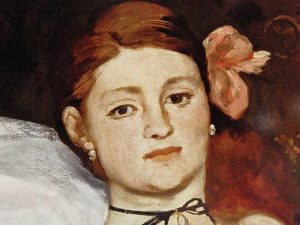
Paris Red is from the perspective of Victorine, a seventeen year old girl who sees the world through a very analytical lens. She is very bold but is very thoughtful about her actions and intentions, which is shown throughout the book as she interacts with other characters, especially when it comes to Manet and Nise. Both are people whom she has a profound connection t, and whose lives change greatly because of her decisions.
Victorine’s decisions end up sending her life into a new direction, and though at times it may seem that Manet is only giving her certain options, she has the ability to influence the situation through her actions. For example, when Manet is talking to the man at Flicoteaux’s, she puts her hand on his leg in order to draw the attention back to herself. She attempts to do so in a way that the man and Nise do not witness. She understands early on that she wants Manet for herself and acts with intent even though she doesn’t really want to hurt Nise: “And I slip my hand over his leg. A secret touch that I tell myself Nise will not see, nor the man who is standing there, talking and talking… And I tell myself she should not care, because even if he had taken the chair beside her, she would not have dared to pivot her arm and touch him” (Gibbon 53-54). This action is a defining moment because it is one of the actions that leads to the divide between Nise and Victorine.
That being said, the actions of other characters are important, too. For example, Manet makes very specific choices that influence Victorine’s decisions, but he does seem to leave room for her to decide for herself. For example, he offers her a job as his model but does not make it so she has to make that decision; he reminds her that she can keep working her current job if she chooses to do so. Perhaps there is an illusion of choice in that, but the fact that he leaves it up to her is important. He seems to find value in her opinion, especially when it comes to art. He shows her many different examples of both his art and that of other artists, and she tells him what she truly thinks. He recognizes how she sees the world and how special that is, and he loves her for that.
Towards the end of the story, Manet tells her to “Make people please you… Make them work for it” (Gibbons 276). Both of them do that throughout the story, and to follow up that statement with the reveal of the painting feels profound. The way the story ends makes it feel like this is just the beginning. There is so much more left for their story, but so much has changed them up until this point. They have changed each other.
I’m not sure I agree that Victorine changed Manet, at least not that we can see from the novel. We know so little about his personality in the beginning it’s hard to tell, but to me he stayed very much the same all the way through, and the only thing that changed was their relationship. In what ways did you notice him changing?